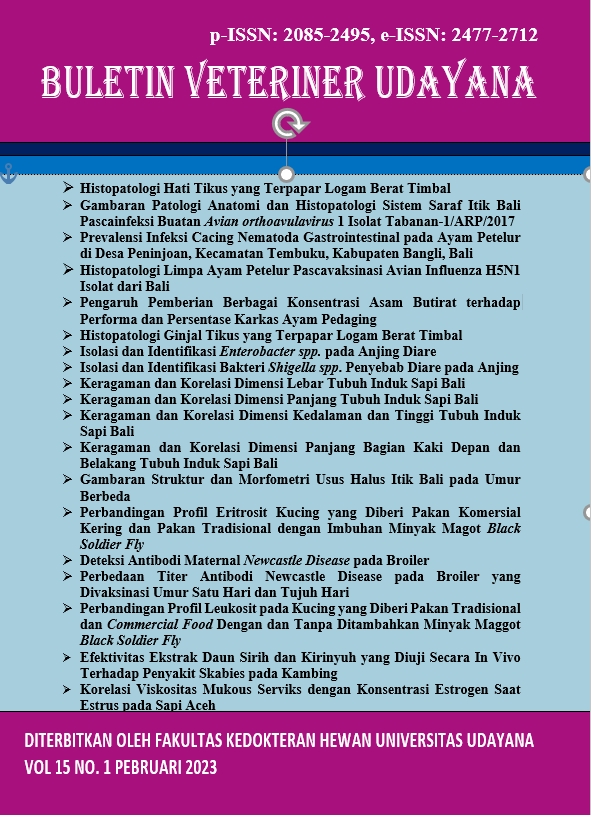ISOLATION AND IDENTIFICATION OF SHIGELLA SPP. BACTERIA CAUSES OF DIARRHEA IN DOGS
Abstract
Dogs are one of the favorite animals that are kept by many people because they are considered intelligent and loyal animals. One of the main health problems of dogs is diarrhea caused by a bacterial infection. Shigella spp. is a pathogenic bacterium in the digestive tract of dogs. This study aims to isolate and identify Shigella spp. bacteria that cause diarrhea in dogs. Samples studied using rectal swabs in dogs showing clinical symptoms of diarrhea with a total of 48 samples from veterinary clinics in the city of Denpasar and its surroundings. Isolation of Shigella spp. was conducted on Eosin Methylene Blue Agar, Salmonella-Shigella Agar, and Sheep Blood Agar. Colonies that grew and separated on Salmonella-Shigella Agar medium were subjected to Gram staining, catalase test, oxidase test and continued with biochemical tests, namely Triple Sugar Iron Agar, Sulfid Indole Motility, Methyl Red Voges Proskauer, Simmons Citrate Agar, and test for sugars such as glucose, lactose, mannitol, and arabinose. The results showed that of the 48 isolated and identified samples, one sample showed a positive result for Shigella spp. with possibly the species Shigella dysentriae. It was concluded that one (2.08%) of Shigella spp. bacteria could be isolated and identified from 48 samples of dog rectal swabs that showed clinical symptoms of diarrhea. It is necessary to conduct further research on the level of pathogenicity of Shigella spp. bacteria and for further research, it is necessary to supplement the API 20E test to determine the Shigella species.
Downloads
References
Atmiati WD. 2012. Faktor-faktor yang berhubungan dengan keberadaan bakteri Escherichia coli pada jajanan es buah yang dijual di sekitar pusat kota Temanggung. J. Kes. Mas. 1(2): 1047-1053.
Batra S. 2018. Morphology and culture characteristics of Shigella Dysenteriae (Sh. Dysenteriae). https://paramedicsworld.com/shigella-dysenteriae/morphology-culture-characteristics-of-shigella-dysenteriae/medical-paramedical-studynotes.
Budiana NS. 2006. Dunia Anjing. Penebar Swadaya. Jakarta.
Dinas Peternakan dan Kesehatan Hewan Provinsi Bali. 2019. Kadis Peternakan menyatakan tren infeksi rabies di Bali alami penurunan. https://denpasarkota.go.id/berita/baca/15441.
Carter GR, Cole JR. 1990. Diagnostic Procedures in Veterinary Bacteriology and Mycology. 5th Ed. Academic Press. San Diego. Pp. 620.
Chandler M. 2011. Solutions Veterinary Practice: Small Animal Gastroenterology. Elsevier. London. Pp. 256.
Cowan ST, Steel KJ. 1993. Manual for the Identification of Medical Bacteria. 3rd Ed. Cambridge University Press. New York. Pp. 331.
Hale TL, Keusch GT. 1996. “Shigella,” in Medical Microbiology. 4th Ed. NCBI Bookshelf. University of Texas Medical Branch at Galveston.
Heymann DL. 2009. Encyclopedia of Microbiology. 3rd Ed. Elsevier. State University San Diego.
Holt JG, Krieg NR, Sneath PHA, Staley JT, Williams ST. 1994. Bergey’s Manual of Determinative Bacteriology. 9th Ed. A Wolters Kluwer Company. Philadelphia. Pp. 187-288.
Isenberg HD. 1992. Interpretation of aerobic bacterial growth on primary culture media. Clin. Microbiol. Procedures Handbook. 1(1): 61-67.
Jawetz E, Melnick JL, Adelberg EA. 2005. Mikrobiologi Kedokteran. 22nd Ed. Penerbit Salemba Medika. Jakarta.
Koneman EW, Allen SD, Dowel Jr VR, Sommers HM. 1983. Color Atlas and Textbook of Diagnostic Microbiology. 7th Ed. J.B Lippincott Company. Sydney. Pp. 61-96.
Lewis HC, Ethelberg S, Olsen KEP, Nielsen EM, Lisby M, Madsen SB, Boel J, Stafford R, Kirk M, Smith HV, Tikumrum S, Wisetrojana A, Bangtrakulnonth A, Vithayarungruangsari, J, Siriarayaporn P, Ungchusak K, Bishop J, and Molbak K. 2009. Outbreaks of Shigella sonnei infections in Denmark and Australia linked to consumption of imported raw baby corn. Epidemiol. Infec. 137(3): 326-334.
Mugford R. 1994. Dog Training the Mugford Way. Stanley Paul Publishing. London.
Parija SC. 2012. Microbiology and Immunology. 2nd Ed. Elsevier. India.
Pramudya IMR, Hendrayana MA, Sukrama IDM, Iswari, IS. 2021. Identifikasi Shigella Dysenteriae pada makanan salad di kota Denpasar. J. Med. Udayana. 10(6): 1-6.
Prihastika E, Savira M, Anggraini D. 2015. Identifikasi Salmonella sp. dan Shigella sp. pada tinja anak dengan diare yang berobat dipuskesmas rawat inap kota Pekan Baru. J. Mikrobiol. 1(2): 1-9.
Putra AAG, Gunata IK, Faizah, Dartini NL, Hartawan DHW, Semara-Putra AAG, Soegiarto. 2009. Situasi rabies di Bali: enam bulan pasca program pemberantasan. Bul. Vet. Udayana. 21(74): 13-26.
Sari DAP. 2012. Isolasi dan identifikasi Salmonella enteridis pada telur saluran pencernaan dan feses ayam ras dari peternakan di gunung sindur Bogor. Skripsi. Bogor: Intitut Pertanian Bogor.
Schroeder GN, Hilbi H. 2008. Molecular pathogenesis of Shigella spp.: controlling host cell signaling, invasion, and death by type III secretion. Clin. Microbiol. Rev. 1(21): 134-156.
Sulaeman LP. 2015. Deteksi bakteri Eschericia coli dan Shigella sp dalam telur balado serta resistensinya terhadap beberapa antibiotik. Skripsi. Jakarta: Universitas Islam Negeri Syarif Hidayatullah.
Supardi I, Sukamto. 1999. Mikrobiologi dalam pengolahan dan keamanan pangan. Yayasan Adikarya IKAPI & The Food Fondation. Penerbit Alumni. Bandung.
Suyana, Eni K, Oktalina Y. 2015. Pengaruh berbagai konsentrasi ekstrak etanol daun salam (Syzygium polyanthum) terhadap daya anti bakteri Shigella dysentriae secara in vitro. J. Teknol. Lab. 4(1): 320-323.
Tjokoprawiro A. 2007. Ilmu Penyakit Dalam. Airlangga University Press. Surabaya.
Venkatesan MM, Hartman BB, Newland WJ, Isanova VS, Hale T, McDonough M, Butterton J. 2012. Infection and Immunity: Construction, Characterization, and Animal testing of WRSdI, a Shigella dysenteriae I Vaccine. American Society for Microbiology.
Volk, W. 1990. Mikologi Dasar. Erlangga University Press. Jakarta.
Wicaksono AR. 2016. Identifikasi bakteri Escherichia coli dan Shigella sp. terhadap jajanan cilok pada lingkungan SD negeri di Cirendeu, Pisangan, dan Cempaka Putih. Skripsi. Jakarta: Universitas Islam Negeri Syarif Hidayatullah.
Zein U, Sagala KH, Ginting J. 2004. Diare akut disebabkan bakteri. Universitas Sumatera Utara. Medan.





